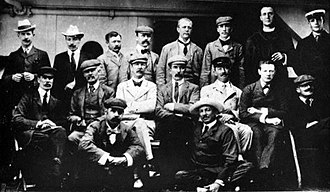Maurice Gifford
Maurice Raymond Gifford | |
|---|---|
 Col. Maurice Gifford, CMG, ca. 1900. | |
| Born | 5 May 1859 Ampney Park, Gloucester, United Kingdom |
| Died | 1 July 1910 (aged 51) London, United Kingdom |
| Allegiance | British Army |
| Years of service | 1882–1893, 1893, 1896, 1900 |
| Rank | Colonel |
| Unit | French's Scouts, Canada 1882–1893; Scout, British South Africa Police, 1893; Rhodesian Horse, Imperial Yeomanry, 1900. |
| Commands | Gifford's Horse, Bulawayo Field Force, Rhodesia, 1896. |
| Battles / wars | North-West Rebellion Mahdist War First Matabele War Second Matabele War Second Boer War: — Relief of Mafeking — Defence of Kimberly |
| Awards | Order of St Michael and St George North West Canada Medal British South Africa Company Medal Queen's South Africa Medal . |
| Other work | Correspondent to the Daily Telegraph, Merchant Service, General Manager of the Bechuanaland Exploration Company. |
Hon. Maurice Raymond Gifford CMG (5 May 1859 – 1 July 1910) was a British military officer.
Biography

Born at Ampney Park, Gloucester, he was the son of Robert Francis Gifford, 2nd Baron Gifford, and the brother of Edric Gifford, 3rd Baron Gifford. On the completion of his education he entered the Merchant Service, and was on board the training ship Worcester for three years. In 1878, he entered the service of the British Steam Navigation Company, in which he remained until 1882, visiting many parts of the globe. That same year he fought in the Mahdist War and served as assistant correspondent to the Daily Telegraph at the time of the engagement of Tel-el-Kebir.[1] He then went to Canada for 11 years and fought in the North-West Rebellion as one of French's Scouts under Lord Minto, earning the North West Canada Medal and clasp.[2] Next, Gifford went to South Africa and became General Manager of the Bechuanaland Exploration Company and soon became involved in the First Matabele War, 1893.[3] In the Second Matabele War, 1896, he was part of the Bulawayo Field Force during the Siege of Bulawayo, raised Gifford's Horse, and lost his right arm to a Nbatabele bullet.

[4] In the Second Boer War he was attached to the Imperial Yeomanry and was part of the Rhodesian Horse. He participated in the Relief of Mafeking.[5]
He married Marguerite Thorold, the daughter of Capt Thorold of Boothby, on 21 September 1897. Among the presents Gifford gave to his wife at the wedding, was the bullet that cost him his arm. He set it in Matabele gold and arranged it so that the yellow metal formed a double-headed serpent.[3]
On 1 July 1910, while undergoing a rest cure for nervous breakdown, Col. Gifford met his death from a fire caused by his clothes being set alight by a cigarette.[6] He had been cleaning his clothing with petrol just before the incident.[7]

References
- ^ Wills, W.A.; L.T. Collingridge (1894). The Downfall of Lobengula. London: American Review.
- ^ Burnham, Frederick Russell (1926). Scouting on Two Continents. New York: Doubleday, Page & company. OCLC 407686.
- ^ a b "Capt. Maurice Gifford Weds". The New York Times. 22 September 1897.
- ^ Creswicke, Louis (1901). South Africa and the Transvaal War. Edinburgh: Putman.
- ^ "The Relief of Mafeking". The New York Times. 23 May 1900. p. 3.
- ^ "Portraits & World's News: Col. Maurice Gifford, CMG". Illustrated London News (3716): 46. 9 July 1910.
- ^ "THE HON. MAURICE GIFFORD. FATAL BURNING ACCIDENT". The Sydney Morning Herald: 7. 5 July 1910.
The Hon. Maurice Raymond Gifford, C.M.G., while undergoing the rest cure at Hoddesdon, a village near Hereford, was discovered rushing through the garden in a mass of flames. Before dying, he said that he had been cleaning his clothes with petrol, when he lighted a cigarette. A doctor stated at the Inquest that deceased had been suffering from acute nervous prostration. A verdict of accidental death was returned.
- ^ "FinestHour" (pdf). Journal of the Churchill Center and Societies, Summer 2005. Archived (PDF) from the original on 8 August 2007. Retrieved 2 August 2007.
- 1859 births
- 1910 deaths
- Military personnel from Gloucester
- British colonial army officers
- Companions of the Order of St Michael and St George
- South African military personnel
- British South Africa Police officers
- People of the Red River Rebellion
- People of the Second Matabele War
- British military personnel of the Second Boer War
- Younger sons of barons
